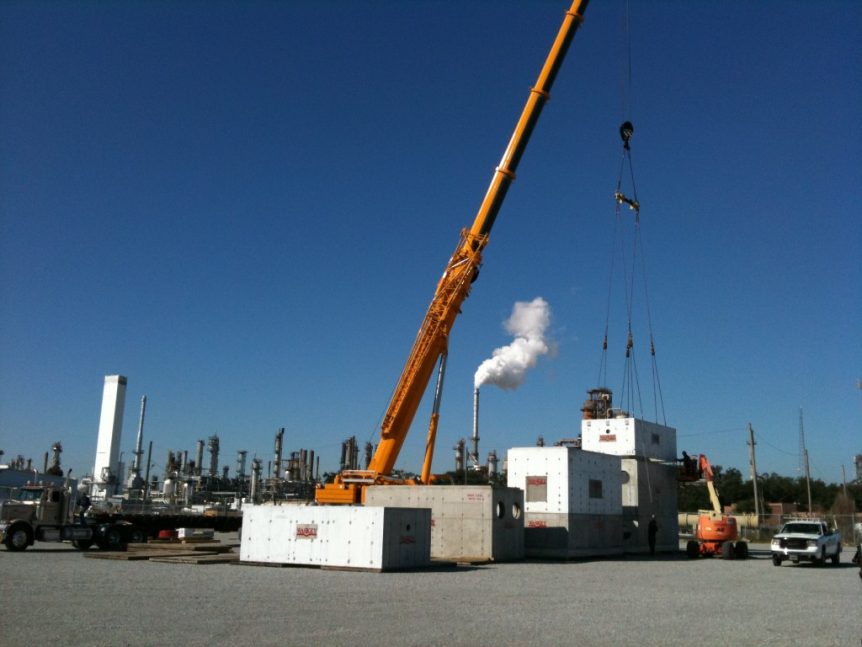
In the final part of this blog series, we will look at the biggest industrial stormwater system in this series: the Chalmette refinery in Louisiana. Chalmette Refining, LLC is a joint ownership venture between ExxonMobil and Petròleos de Venezuela. Romtec Utilities supplied a very unique stormwater pump station capable of servicing the entire refining facility.
ExxonMobil and Engineering and Inspection Services, LLC. (EIS) came to Romtec Utilities to help them solve a problem. The Chalmette Refining plant had an aging stormwater pump station that needed to be replaced. ExxonMobil and EIS chose precast concrete as the preferred method for installing a new sump, but a precast structural member that large was challenging. They did not find a willing designer for the 6,500 cubic feet rectangular sump until they contacted Romtec Utilities.
Romtec Utilities’ engineers also recognized the difficulties for the specified precast component, so they chose to engineer and propose a different approach. The new design broke up the sump into three separate precast rectangular vaults. Each vault was connected by four large pipes at the bottom and top of the adjoining walls. The new design would function just like a single precast vault, but it provided a much more reliable sump component.
The precast sumps were fitted with all the spools, fixtures, hatches, connective piping, pump mounts and bolts, and electrical grounding plates during the prefabrication. Another unique element during this stage was a giant stainless steel baffle prefabricated into place in front of the inlet line. The existing inlet line for this system was specified at 48 inches ID and would deliver 30,000 gallons per minute of stormwater. The amount of force generated by such a large flow of incoming stormwater needed to be minimized to protect the submersible pumps and other wet well fixtures. The large baffle would slow the water inflow and direct the flow toward three submersible pumps.
Two submersible pumps were housed in the first stage rectangular wet well and the third submersible pump was located in the front of the second stage wet well. Behind this pump was a 15-foot-tall retaining weir wall that contained the dirtiest water with the submersible pumps. If water levels climb above the weir wall, the water spills over into the rest of the second stage wet well and can flow into the entire third stage as well.
On the far side of the retaining weir wall, two vertical turbine pumps were in second stage wet well and three additional turbine pumps were located in the third stage wet well. To summarize, three stages of connected rectangular sumps were split into two divisions. The first division used three submersible pumps and the second division used five vertical turbine pumps.
This design was chosen for a few reasons. Submersible pumps are more capable of pumping gritty and turbid water, making a preferable first line of defense. The eight total pumps do not pump to the same location. This pump station discharges to several different holding tanks where the water is pumped via a separate system to an on-site oil/water separator. The Romtec Utilities station preserved the existing holding tank discharge priority. The entire precast pump station was placed inside of the existing sump and backfilled with concrete slurry.
The Romtec Utilities and EIS design allowed ExxonMobil to utilize several pumps that it had in stock. EIS and ExxonMobil chose to use Chalmette Refining staff to install electrical components and system controls. Romtec Utilities acted as a consulting agency to assist ExxonMobil and EIS develop the control system for level sensing to start and stop the pumps and to control the order in which the pumps proceeded.
This industrial stormwater pump station is as large as it is sophisticated. Romtec Utilities was able to engineer a package pump station capable of meeting the requirements of ExxonMobil and EIS. Romtec Utilities also worked to develop plan that would allow ExxonMobil and EIS to manage specific aspects of the system like the pumps, radar level sensing, and system controls. This approach led to a fully functional pump station that met all requirements and provided substantial financial savings to ExxonMobil.
This industrial stormwater blog series covered seven unique and interesting projects that Romtec Utilities completed. Industrial companies deserve credit for their efforts in environmental responsibility with stormwater. This series sought to showcase their efforts. Romtec Utilities supplied each of these companies with a functional and sophisticated system that will manage their stormwater for decades to come.

